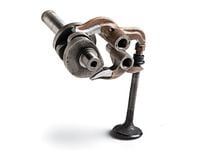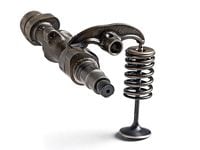Ever since humans invented internal combustion, opening and closing the valves to the combustion chamber has been a problem. The way they dance methodically with the piston—letting the fresh stuff in and the used stuff out—is as essential to our pastime as any cog, connection, or mechanical movement. Springs have long been the standard way to close valves, but they also have inherent limits. Inside an engine spinning at thousands of revolutions per minute, pushing against a spring to open a valve saps quite a bit of energy, and waiting for the spring to push the valve closed again takes precious time.
From the Greek desmos, meaning link or bond, and dromos, meaning path or track, desmodromic valve systems do away with springs altogether. Desmodromic valve actuation has existed for more than 100 years, but it was immortalized in motorcycling by Fabio Taglioni. The Ducati engineer designed a new breed of V-twin that swept into prominence in the early 1970s, and those engines have since come to define the brand.
Instead of compressing a spring to push the valve open and then waiting for the spring to return the valve to its starting position, a desmo rocker arm that opens the valve works in conjunction with a forked counterpart that rides against an inverse cam profile to pull the valve back against the seat. There’s no energy wasted compressing a stiff spring, and there’s no need to wait for the spring to close the valve. In fact, according to Ducati CEO Claudio Domenicali, that’s the desmo’s main advantage. “It’s not only the resistance,” he said when asked about desmo technology. “The way you can open the valve is far more aggressive. You are more efficient in terms of fluid dynamics.” More aggressive cam profiles result in more gases making their way into and out of the combustion chamber with each revolution, and more mixture means more power from the engine.
Those advantages are sometimes noticeable when Ducati's MotoGP bike is in a sprint race with the machine of another manufacturer down a long straightaway. It's less obvious when you ride any other Ducati, but the same technology is there in every model the Italian manufacturer produces. Even though most other engines on the road today still use valve springs, the brutal physics of speed and resonance inside a cylinder head have always been the scourge of those crucial coils of wire. And so Ducati has stuck with the desmo valve system—much like other Italian marques stick with the tradition, the passion, and the style that make Italy unique.


/cloudfront-us-east-1.images.arcpublishing.com/octane/IN263JIBTBCD3O265IMSCW6OZM.jpg)
/cloudfront-us-east-1.images.arcpublishing.com/octane/SMAQ354X2JH7NJATXNSQY4NRS4.jpg)
/cloudfront-us-east-1.images.arcpublishing.com/octane/GGOH2AQRSVHY5C5JLNEVYLB5SU.jpg)
/cloudfront-us-east-1.images.arcpublishing.com/octane/TJJEHV3ATZFFXHUYZABHXKE2DI.jpg)
/cloudfront-us-east-1.images.arcpublishing.com/octane/WIC4RXQ36BAXNIW6U4UJ3XDLKI.jpg)
/cloudfront-us-east-1.images.arcpublishing.com/octane/B4PQZLY4LBHITGE5ZRRM2N5YNU.jpg)
/cloudfront-us-east-1.images.arcpublishing.com/octane/OBYS7KWZUJFCHD44YPTSVM5EF4.jpg)
/cloudfront-us-east-1.images.arcpublishing.com/octane/FY7ZXYBT4NH2NGYQIWQVITS4AM.jpg)
/cloudfront-us-east-1.images.arcpublishing.com/octane/JPET6WQUDZEYLNXVY5LRNDRPLA.jpg)
/cloudfront-us-east-1.images.arcpublishing.com/octane/EY6P2QIFQJCDTNOMR3JB7WJED4.jpg)
/cloudfront-us-east-1.images.arcpublishing.com/octane/V2U6JB7KXNCQRN4OW6HNJTVMZQ.jpg)
/cloudfront-us-east-1.images.arcpublishing.com/octane/AMS43BT5ABH77NY7XKLCSZCNM4.jpg)
/cloudfront-us-east-1.images.arcpublishing.com/octane/NTK2ASYKUBDW5MQDWQLVQYOELY.jpg)
/cloudfront-us-east-1.images.arcpublishing.com/octane/SX7R3KCIANGDBGF45O73F543TM.jpg)
/cloudfront-us-east-1.images.arcpublishing.com/octane/ZTW4V7RAPFG6RFWJRXR2IX5ZQ4.jpg)
/cloudfront-us-east-1.images.arcpublishing.com/octane/EPRSLPIUTBC5RPD7R263BPV2D4.jpg)
/cloudfront-us-east-1.images.arcpublishing.com/octane/EMJ4I2T4HVCRVJPZ3UJFVMRDHA.jpg)
/cloudfront-us-east-1.images.arcpublishing.com/octane/CBDAM3VMJNFDBLE7Y3FY7RD5BY.jpg)
/cloudfront-us-east-1.images.arcpublishing.com/octane/CCEB3TNMU5FH3OZ4FKJ7DA2LBA.jpg)
/cloudfront-us-east-1.images.arcpublishing.com/octane/VV6N3KUWEVFJJD7F7VX6ICOH7Q.jpg)
/cloudfront-us-east-1.images.arcpublishing.com/octane/R55SVEXZ5VA2LCWFWYR647ASX4.jpg)
/cloudfront-us-east-1.images.arcpublishing.com/octane/MYWIEFOQ6JCCNDR4OBF5PU5LVE.jpg)
/cloudfront-us-east-1.images.arcpublishing.com/octane/OOZ3C4GCUJGRNONDI6DHVM57GI.jpg)
/cloudfront-us-east-1.images.arcpublishing.com/octane/JEKB3CMWXZD6ZAVFEDKLOQ5FNY.jpg)